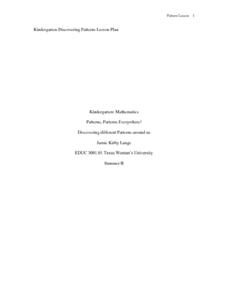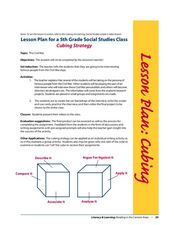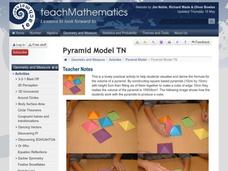Texas Woman’s University
Patterns, Patterns Everywhere!
Not only is pattern recognition an essential skill for young children to develop, it's also a lot of fun to teach! Over the course of this lesson, class members participate in shared readings, perform small group activities, and complete...
Curated OER
Context Clues
For this context clues worksheet, students read the sentences and choose the best meaning of the underlined word. Students complete 10 online questions.
Curated OER
Cubing Strategy
Fifth graders interview each other in the role of civil war personalities. In this Civil War lesson, 5th graders create a script and video of an interview with classmates who are portraying characters from the Civil War. Students are...
Curriculum Corner
8th Grade Math "I Can" Statement Posters
Clarify the Common Core standards for your eighth grade mathematicians with this series of classroom displays. By rewriting each standard as an achievable "I can" statement, these posters give students clear goals to work toward...
Ontario
Critical Literacy—Media Texts
Media texts convey both overt and implied messages. As part of their study of media, class members analyze the language, form, techniques, and aesthetics in a variety of media texts.
Mathed Up!
Factors, Multiples, and Primes
Reinforce the concept of factors, multiples, and prime numbers with a 16-problem practice instructional activity. Eight pages offer a variety of problem solving opportunities with clear objectives and tips for successful completion.
Curated OER
March of the Dividing Ant
Young scholars inspect divisibility rules. In this divisibility rules lesson, students study the relationship between factorization and the divisibility rules for 2, 3, 5, 6, 9, and 10. Young scholars read One Hundred Hungry Ants and A...
Curated OER
Place Value
Third graders review place value by arranging four numbers to make the highest number possible. They are shown a hundred flat. Students are asked to show another way of making 100 using base-ten blcoks. They are then shown a thousands...
Curated OER
Poetry Cubes
Middle schoolers develop an appreciation for different styles of poetry and learn different techniques for memorization.
Curated OER
Reaching Students through Literacy Centers
Continue the celebration of literacy this month by integrating reading centers into the classroom.
Curated OER
Nothing But Problems
Here is a fabulous lesson on problem solving in the mathematical world. In it, third and fourth graders get lots of great coaching on how to approach word problems, and how to best find a solution. They watch an episode of Reading...
Curated OER
Worksheet 19: Ship Positions
In this math worksheet, learners read informational paragraphs and then answer 18 questions using data from their readings. Questions are about vectors, positions, distance and orbits.
Curated OER
All About Money
Few topics engage young mathematicians as much as learning about money. Through a series of shared readings and hands-on activities, children explore the US currency system, learning how to count money and calculate change as they create...
Curated OER
Graphs of Formulas
In this worksheet students fill out a function table after reading a short word problem. This is a good way for students to practice the necessary skills for solving word problems or setting up algebra equations.
PBS
Blue Ribbon Readers: Questioning
Model for your class how to become a better reader through questioning. After conducting a picture walk that introduces prediction strategies, learners play an interactive questioning cube game. Complete directions for the game and...
Curated OER
Patterns
Students explore simple patterns. In this mathematical thinking geometry lesson plan, students repeat clapping and snapping patterns, and determine what comes next in sound and movement patterns. Students recite "Hey, Diddle, Diddle,"...
Florida Center for Reading Research
Phonological Awareness: Sentence Segmentation, Nursery Rhymes
What makes a complete sentence? Words, of course! As your budding readers understand this relationship, guide them through this nursery rhyme activity. Scholars examine pictures of 10 familiar rhymes, mentally counting the words in the...
Curated OER
Measuring Up
Students examine and discuss a variety of ways to measure length, capacity, and weight. They estimate and measure a pencil's length using Unifix cubes, estimate and fill a measuring cup with Unifix cubes, and weigh a calculator in a...
Illustrative Mathematics
1.OA, NBT, The Very Hungry Caterpillar
First graders are exposed to addition of three whole numbers in a math activity centered around Eric Carle's, The Very Hungry Caterpillar. As the teacher reads, young mathematicians use counters and ten-frames to symbolize the number of...
Curated OER
Cool and Not-So-Cool Materials
Why do some materials feel cool to the touch, but not others? Learn about thermal conductors and thermal insulators with a fun science experiment. First, kids read the results of an experiment with spoons and hot water. They then try...
Jim Noble, Richard Wade & Oliver Bowles
Pyramid Model
Seeking to derive the formula for the volume of a square pyramid, geometry learners construct six square based pyramids that, when pieced together properly, form a cube. Two short videos demonstrate the relationship between pyramid and...
ReadWriteThink
Biography Project: Research and Class Presentation
I Have A Dream ... that after the lesson, all individuals master the reading, writing, researching, listening, and speaking skills the biography project helps them develop. Martin Luther King, Jr. serves as a topic example for a model...
Utah Education Network (UEN)
Add a Quack, Quack Here
The teacher will read-aloud the book Quack and Count and call upon studens to demonstrate various sums of seven. They brainstorm a list of ideas of things that can be combined or added together. They are given unifix cubes to demonstrate...
Noyce Foundation
Building Blocks
Building blocks have more uses than simply entertaining children. Young mathematicians calculate the volume of a given cube, and then calculate the volume and surface area of a prism formed from multiple cubes.

























